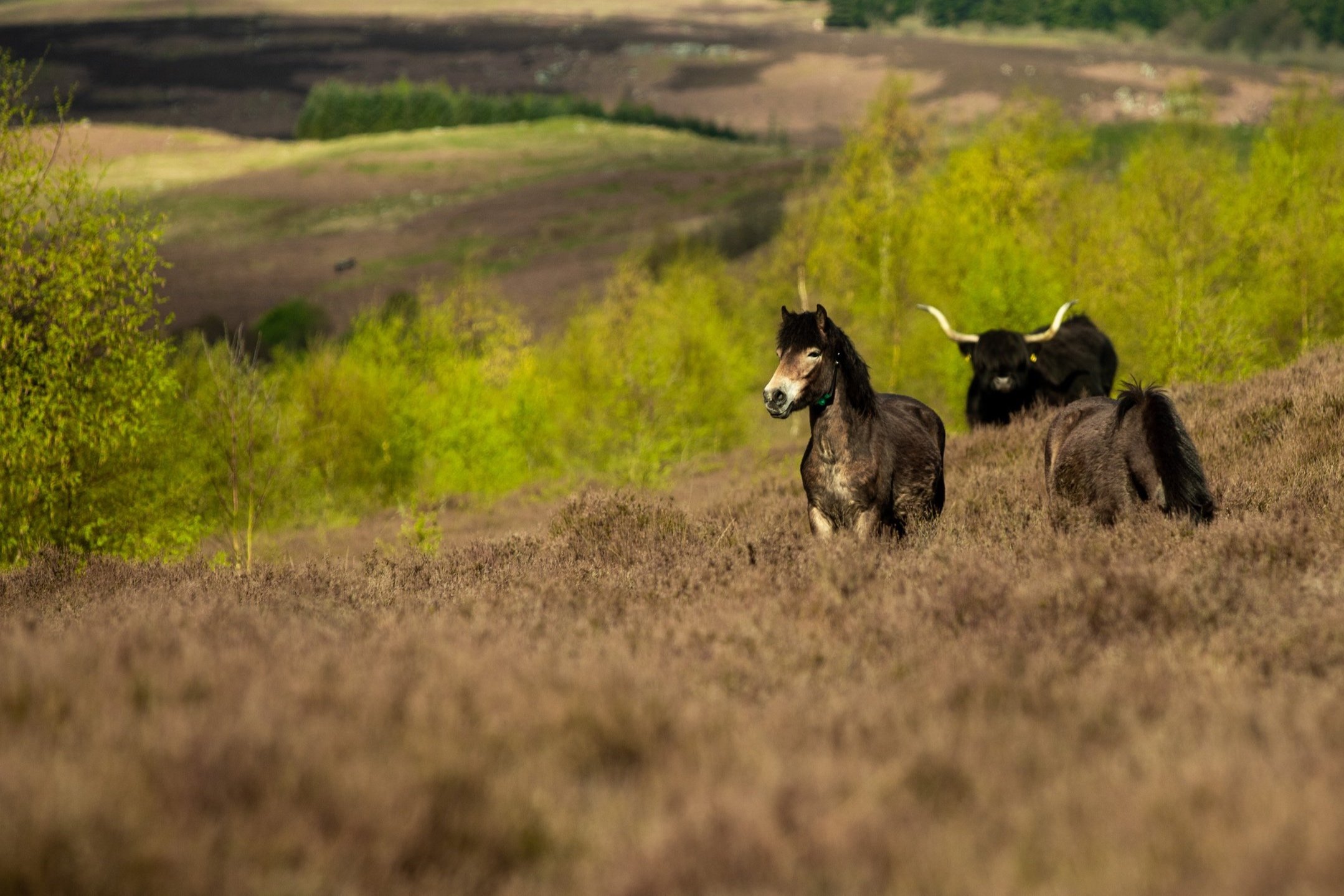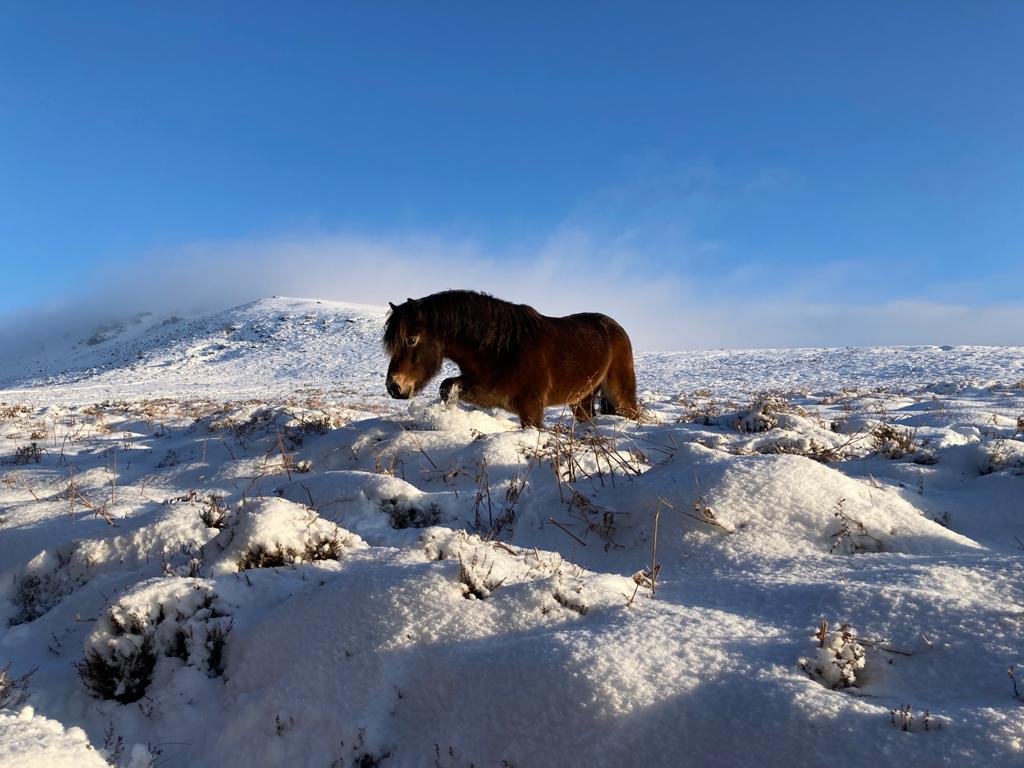
Invigorating nature
Our Ethos: Managed Wilding
The Hepple estate is host to some wonderful charismatic species. We have curlew, red grouse and lapwing which are characteristic of open moorland and upland sheep farms, but despite decades of classic conservation work, we have not found it easy to outgrow the national pattern of decline.
In 2020 we started on a radical new direction with a plan we call ‘managed wilding’. This looks at building the base of the food-chain, from water, soil carbon and fungal mycorrhiza to diverse vegetation and the insect population.
We hope this will amplify biodiversity ‘significantly over the whole 4,000 acres, and help support both the rare species we have and be an attractive place to settle for those we have lost.
Our regime uses ‘pulsed’ organic grazing, naturalistic tree and shrub planting, and wetland creation. We are smudging hard edges to increase the interconnectivity, removing fences to allow animals to express natural herd behaviour. We believe natural processes are best to reinvigorate the whole ecosystem, but also allow for subtle, gentle intervention where our expert advisers suggest doing so.
Our future landscape
Upland woodland emerging from natural regeneration, notably of birch, alder, rowan, willow, hawthorn, hazel, holly, Scots pine plus juniper and aspen.
Expanding wetlands supporting wider insect life.
Greater densities of scrub and woodland birds.
More complex and more abundant fungi.
A more resilient, more abundant, more surprising landscape.
Managed Wilding
We believe natural processes rebuild ecosystems best, so our interventions are only made where we have ecosystem “voids” - in species and structures that our expert advisors have helped us identify.
Changes to date
Removed over 10km of internal fencing
Removed the Blackface sheep flock
Introduced pedigree Longhorns, Exmoor Ponies and Highland cattle
Converted to organic, certified by the Soil Association
Pasture Fed Accredited by Pasture for Life
Created four wetland systems over a total of 7 acres.
Undertaken over 400 acres of peat restoration including on Boddle Moss, one of Northumberland’s deepest peat bogs.
Planted saplings to build native woodland and scrub species (including home-grown juniper).
Created significant amounts of vital dead wood habitat when restructuring plantations to create mixed native woodlands
Monitoring Partners
Bats and Birds: BTO, bioaccoustics with the help of Rewilding Britain
Vegetation: Natural England, Haycock & Jay
Soil Carbon: Agricarbon
Deer: Altana Europe
Full ecosystem system, including eDNA of soils, insects and mammals: Newcastle University
The revival of microscopic life, and reintegration on the landscape level gives the structure for a range of new habitats and species. It gives space for the spontaneous revival of animal and plant life like creeping willow, Celandine, orange-tipped butterflies and a range of dragonflies, our icon, all that we find now just three years into our new regime. As the range of our habitats improve we would expect to add new “lost” species into the mix. We will be guided by our ecology advisory group in how and when to do so.
Following this system creates carbon with biodiversity. It leads to biodiversity that is sustainable and self-supporting. It means we work with nature, rather than against it in the production of our farmed products. And it we hope it gives visitors and residents a sense of connection with a wild ecosystem that is thrumming with health.
The Hepple Ethic
We believe ecological renewal starts at each end of the size spectrum: microscopic and landscape.
At the microscopic level, we focus on water quality by eliminating imported chemicals, slowing run-off and holding water in scrapes and ponds. For soil quality we look to ‘pulsed’, organic grazing to build carbon, rare nutrients and biochemical life.
We are seeing this working in an invigoration of our fungal and insect life and a wider range of vegetation. These are the building blocks for life further down the food chain.
At the landscape level, we are working to reduce or remove the hard man-made partitions of past land use, allowing free-flowing grazing. We are introducing scattered areas of scrub and wood plantations in species like willow, juniper, blackthorn and aspen. We have established a number of wetland areas on the lower ground and increased the water retained on the moor by blocking the ‘grips’ or ditches that were cut into the peat in the 1970s and 1980s. We have also radically changed the grazing away from sheep towards a range of herbivores including Exmoor ponies and pedigree Highland and Longhorn cattle. From 2024 we will be introducing a small number of pigs. A walk around Hepple today reveals a landscape that already looks and feels much wilder.
“Wild thing, you make my heart sing”
Reg Presley, of the Troggs. 1965







